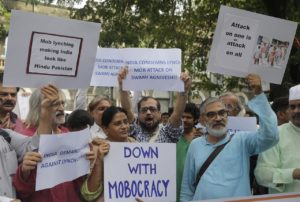Lynching: India wakes up, sets up committee on mob violence
India has finally woken up to the need to curb increasing mob violence and lynching. To this end, it has set up two high-level committees. Will it effectively rein in the self-proclaimed Hindu vigilantes ahead of the 2019 general elections?
Lynching is a barbaric phenomenon across the globe. During the last four years, India has turned into mobocracy with self-proclaimed Hindu vigilantes lynching minorities and Dalits in the name of protecting cows—much revered by devout Hindus.
With less than a year to go for the general elections in 2019, the ruling Bharatiya Janata Party (BJP), headed by Prime Minister Narendra Modi, has finally woken up to widespread lynching and has appointed two high-level committees to suggest a legal framework to curb the scourge.
First, the committee will be chaired by Union home secretary Rajiv Gauba, to formulate appropriate measures to deal with such incidents. Then, the recommendations of the panel will be examined by a group of ministers led by home minister Rajnath Singh, which will then submit its report to Prime Minister Narendra Modi for a final decision.
External affairs minister, Sushma Swaraj; Road Transport and Highways; shipping minister Nitin Gadkari; Law and Justice minister Ravishankar Prasad; and Social Justice and Empowerment minister Maneka Gandhi are the members of the group of ministers headed by Rajnath Singh.
The committee will examine the issue of establishing mob lynching as a separate offence and the legal framework under which this can be done.
Lynching is not new to India. It has existed for centuries except that it is now taking new forms. There are three types of lynching prevalent in India.
The first type of lynching is part of witch-hunting. The second type pertains to the historical issue of caste violence against the Dalits. Caste atrocities often include lynching but are generally under-reported. The aim is usually to intimidate by way of making an example. The first case of mob lynching based on cow protection was based on a rumour of cow slaughter in 2002, where five Dalits from Haryana were lynched by a frenzied mob. The third includes lynching incidents, which have occurred during riots or have instigated riots, for instance, in Muzzafarnagar as well as in Kokrajhar. These incidents are part of communal violence and rioting and must be considered separately. While the third type gets reported in the media, as it has a political and communal angle the others go unreported both by the police and the media.
Is the current legal framework inadequate to deal with the crime? Do vigilantes get political patronage to incite violence and kill? Is it the conspiracy of silence that emboldens the perpetrators?
For most of the time the government has remained silent. In some cases they have supported the perpetrators. Union minister Jayant Sinha recently garlanded the men convicted of lynching cattle trader Alimuddin Ansari in Jharkhand last year. The convicts had gone to meet Sinha immediately after being released on bail following an order by the Jharkhand High Court. The Court had suspended their life sentences, earlier given by a fast-track court on June 29. Later, he regretted garlanding them.
On July 17, a Supreme Court bench, headed by chief justice of India Dipak Misra, termed incidents of mob lynching in India as ‘horrendous acts of mobocracy’ and directed the Parliament to draft a new legislation to effectively deal with incidents of mob lynching across the country. The apex court explicitly directed the police to register an FIR under Section 153A of the Indian Penal Code against those who indulge in such activities and do everything in their power to ensure that social order was maintained.
Following the apex court’s direction, the Union home ministry has issued an advisory to all states to initiate measures to prevent mob violence and lynching and take stringent action as per law.
According to Ravi Nair, of the South Asian Human Rights Documentation Centre, existing laws under the Indian Penal Code and Criminal Procedure Code are quite adequate to deal with the crime. “Where is the political will in the ruling class and in the police to crack down on those indulging in such horrendous crimes?” he asks.
Unless the police and law-enforcing authorities are active and held accountable both for preventing such crime and for their inaction after the incident, the mob violence will grow. Aided by rumours on social media, patronised by political parties overtly and covertly, ignored by the police, and dragged over the years in the courts, vigilantes are having a field day. Ahead of the general elections, if mob violence continues, it will only polarise the electorate on caste and communal lines.










